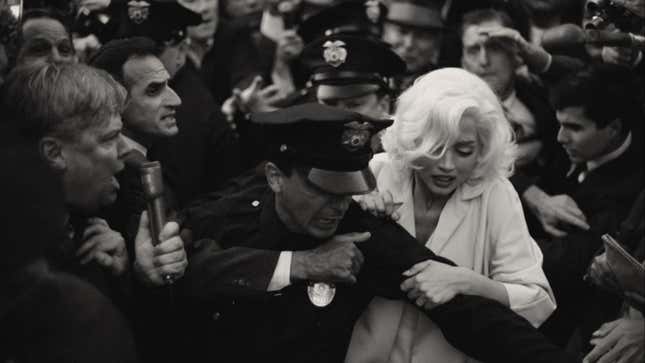The Talking Fetus Gimmick and Ceaseless Brutality in ‘Blonde’ Ruin Its Potential
I'm not sure how a film with a miracle-of-life-ass talking fetus is supposed to make us consider Marilyn Monroe's life more seriously.
EntertainmentMovies

In the first few minutes of Andrew Dominik’s Blonde, a young Norma Jeane (not yet Marilyn Monroe) sits beside her manic mother as they drive up the Hollywood hills and into a blazing fire. For the rest of the two-hour and 46-minute film, we remain there, emotionally. The NC-17-rated film holds the audience hostage, as we watch the near-constant brutalization of Monroe at the hands of men in power, men in her romantic life, men in her audiences, and one anonymous man claiming to be her father who sends her letters throughout the movie. We never get a glimpse of the charismatic, funny, and seductive star that captivated a nation—except for a few brief clips of audiences watching her movies in theaters.
At times, Dominiks’ bold visual direction was effective, like when flashes of empyrean white light transport a drugged Monroe between semi-consciousness on a plane, into a movie theater, and back to the plane again. His choice to switch between scenes in technicolor, in black and white, and in a shifting aspect ratio plop us into instantly recognizable vignettes of Monroe’s photographed life and are supposed to play up the chasm between who she is and what she represents. The high contrast in a few of the black and white scenes accentuates her eponymous hair, highlighting her solitude amidst throngs of lecherous men. It’s a striking visual that nails her horrible fate. But Jesus—we get it. Her fate. It’s horrible, from start to finish. Dominik set out to highlight the tragedy of Marilyn’s inner life, but I’m not sure we see her inner life, as much as we just see her being raped and brutalized up close.
-

-

-

-

-

-

-

-

-

-

-

-

-

-

-

-

-

-

-

-

-

-

-

-

-

-

-

-

-

-

-

-

-

-

-

-

-

-

-

-









































